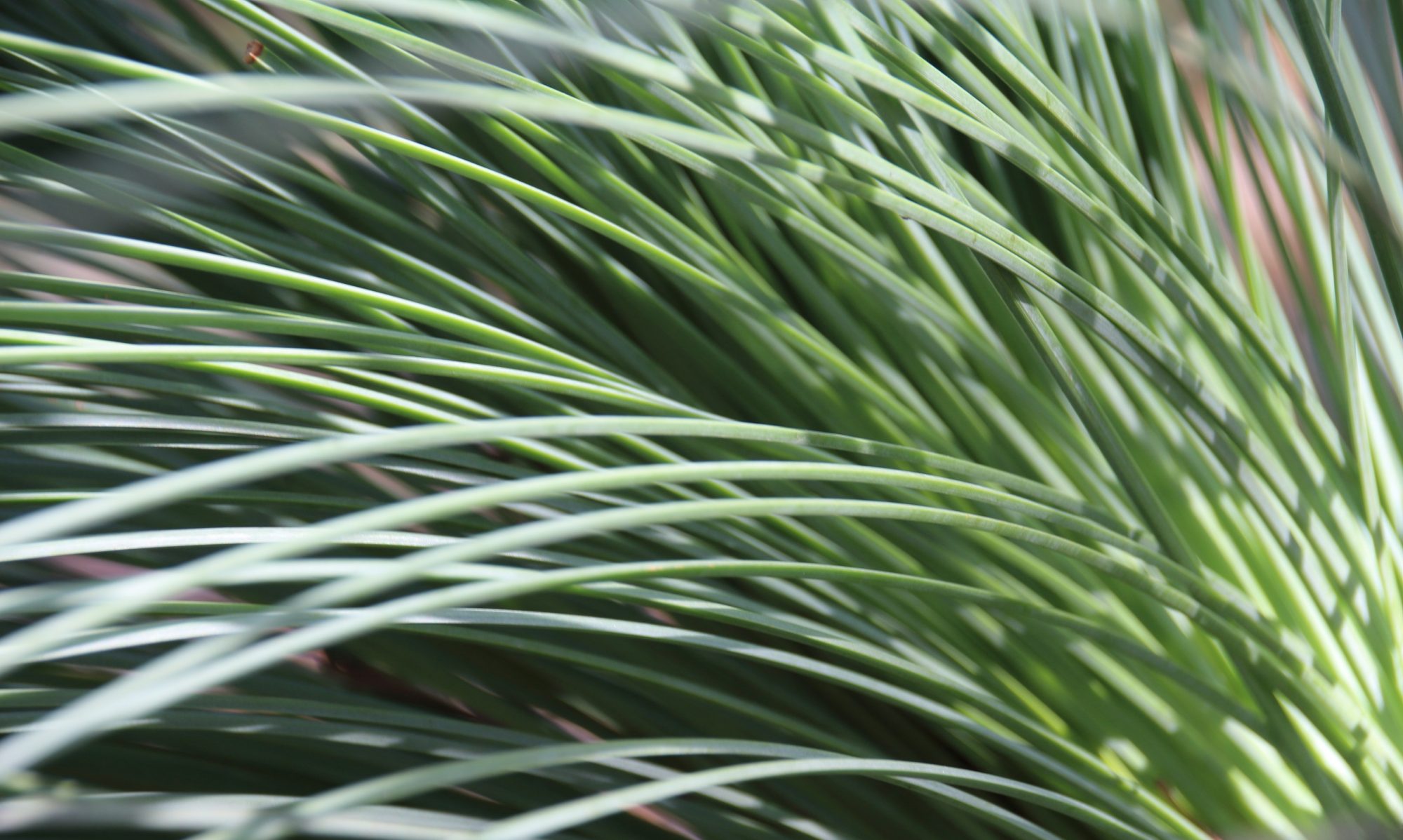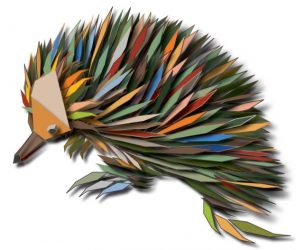- 8th Wildflower Walk
The 8th annual wildflower walk was held between Sunday October 29th and Sunday November 5th along the Dementia Forest and Sensory Trail in Woowookarung Regional Park.
The walk was designated “Seniors Friendly” and listed on the “Victorian Seniors Festival” October calendar.
Over 700 visitors walked the trail. The feedback from the walk was very positive.
Thirty-seven different wildflowers, shrubs and trees were highlighted with pop up signs along the walk. The Field Naturalists Club of Ballarat identified the wildflowers and the rest is up to nature.
This year wildflowers were able to be identified by QR codes on each sign. The QR codes are linked to the FoCC website.



- XMAS Drinks at the Lookout
The 7th annual FoCC drinks and nibbles at the Lookout was held on Friday 1st December 2023.
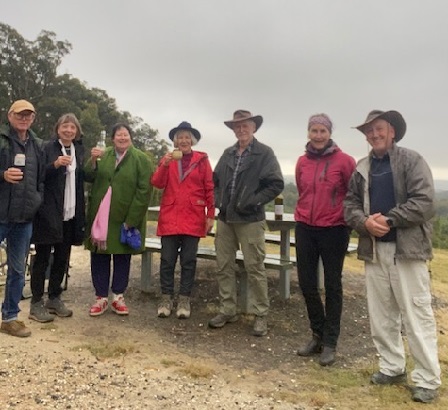
A cool and rainy day, but warmly celebrated by a small band of Foccers.
- Annual General Meeting and Election of FoCC Committee for 2024
The annual general meeting of the FoCC was held on Wednesday November 1st 2023 at the Community House Buninyong.
The election of the committee members for 2024 was undertaken and the positions elected were:
President: Bob Hartmann
Vice President: Carolyn Barry
Secretary: Jeff Rootes
Treasurer: Peter Darveniza
Committee members: Jo Kelly, Joel Ellis, Tarn Kruger, Rob Loveband, Tracie Currie, Joan Brick and Hayley Ingles
No further nominations were received and all were declared elected by the Chairperson Blake Gordon, in record time!
Guest speaker at the Annual General Meeting was Dr Sarah Preston.
Sarah Preston is a lecturer & course coordinator in veterinary science/early career researcher at the School of Health & Life Sciences, Federation University Australia, Ballarat, Victoria.
Sarah is overseeing Koala research in Woowookarung RP and surrounding areas into what happens to Koalas and Echidnas that are released back into the wild after having been rescued by wildlife carers. The program is also focussing on powerful owls as an important apex predator.
The program aims:
- Track koalas and echidnas upon release to observe how they move about and use the habitat.
- In the future to track powerful owls also.
- Current tracking funded by DEECA has just started and one Koala “Catherine” and two echidnas are providing tracking.
- The tracking may identify other Koala populations, habitat and injury hot spots.
- Bird of the Month XXVI (November 2023)
Australian Wood (Maned) Duck (Chenonetta jubata)
Okay, so the Canadian Corridor, and indeed our beloved Woowookarung Regional Park, are both primarily characterised by dry heathy, open eucalypt forest. Granted that, it doesn’t preclude the influence of – or FoCC’s vested interest in – aquatic habitats interspersed throughout the Corridor, including Yarrowee River and its tributaries and creeks (some unnamed), lakes (e.g. Esmond), reservoirs (i.e. Kirk’s, Gong Gong, White Swan), and dams. And where there is surface water, there’s a whole, different assemblage of many, varied waterbirds.
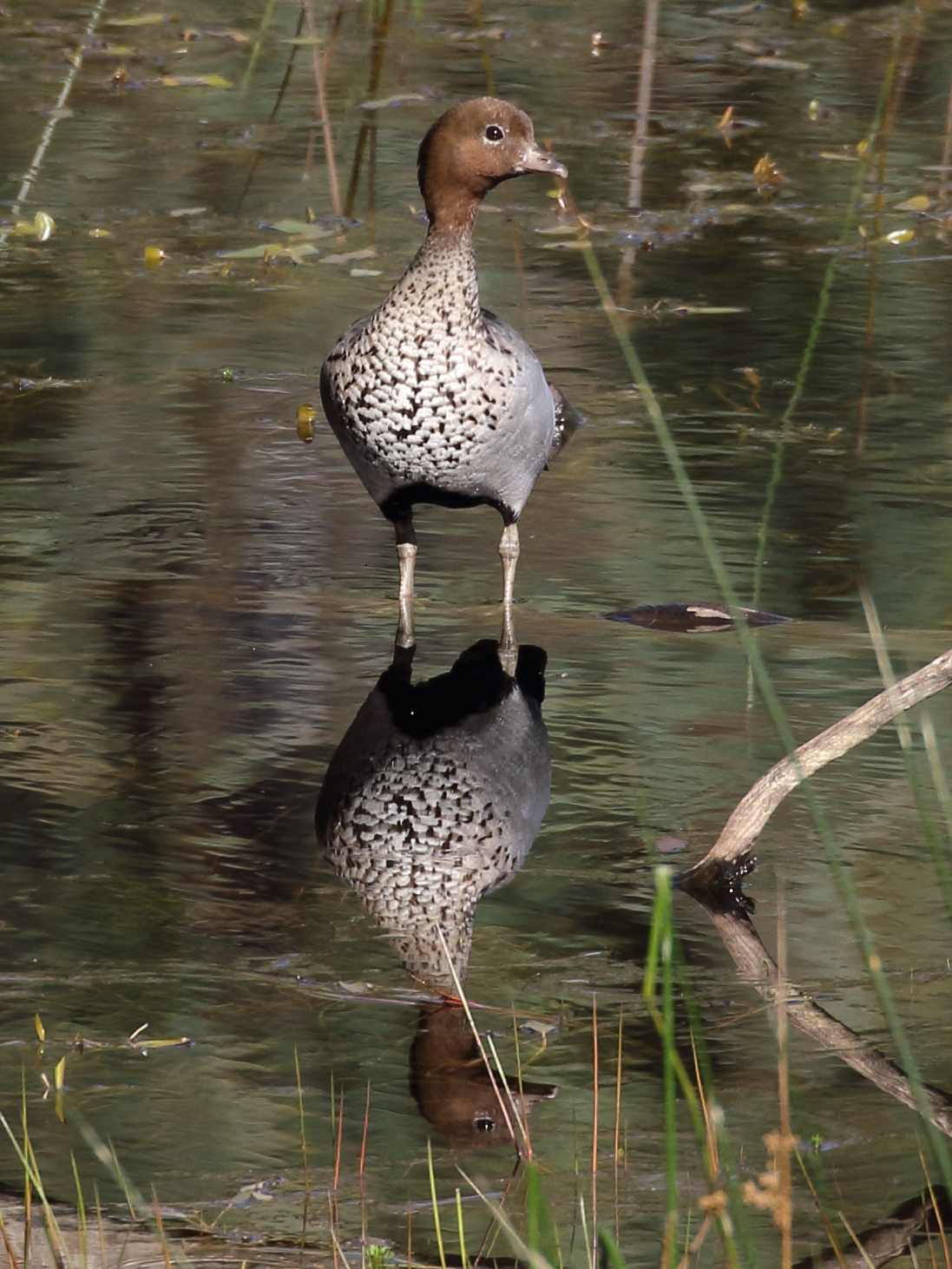 There is no better representative of a merger between dry land and water than the Australian Wood (Maned) Duck. Where some waterbirds may be observed flying over Woowookarung, or taking up residence in a nearby dam or flooded paddock, the Australian Wood Duck will go one further and nest in forest – sometimes far away from water.
There is no better representative of a merger between dry land and water than the Australian Wood (Maned) Duck. Where some waterbirds may be observed flying over Woowookarung, or taking up residence in a nearby dam or flooded paddock, the Australian Wood Duck will go one further and nest in forest – sometimes far away from water.
The Australian Wood Duck, also known as Maned Duck (or erroneously, Maned Goose), is a handsome, goose-like (i.e. long neck and upright posture) duck that gets its alternative name from the male’s mullet-like hairdo. The origins of the ‘Wood’ of its common name are unclear, with a number of theories posited. Such theories include its chestnut head being a colour reminiscent of wood, or the species’ affinity with wooded habitats, given it nests in tree hollows and perches in eucalypts and on logs. Name origins aside, these pale grey ducks (44-50cm) with the brown-grey speckled breast and black wing stripes, are dabblers that forage on land, grazing on grasses and herbs (and occasionally insects) of lawns, grasslands, flooded or irrigated croplands, and littoral zones (i.e. the shores and shallow extremities of lakes, dams, sewage ponds, and estuaries). Thus, they are not avid swimmers and certainly far-removed from divers, but may upend in the shallows, and will retreat to open water when disturbed.
Males have a richer chestnut head/neck than females, while females have more extensive mottling, and faint white stripes above and below the eye. The species forms monogamous pairs that remain bonded year-round. This is a highly social species that may congregate in flocks as abundant as 2,000 individuals. Breeding season is September through November in the south of Australia, but elsewhere they may breed any time of year following sufficient rainfall. As aforementioned, the species nest in tree hollows, which may be waterside or a considerable distance away from water. A chosen tree hollow is often reused, year after year. Artificial nest boxes may alternatively be used. The primary nest material is downy feathers. Clutches of 9-11 eggs are incubated over 28 days, and young remain with parents a month after fledging.

As a duck that sometimes nests far away from water, Australian Wood Ducks are a species hardened with a tenacity, born out of being predisposed to enduring the long, annual trek from the hollow to a suitable feeding ground, with ducklings (not yet fledged or capable of flight) in tow. Often this entails duck families crossing, high-traffic, high-speed roads, or car parking lots. While they haven’t garnered the reputation of Australian Magpies or Masked Lapwing (colloquially, ‘Plovers’), if any species embodies a seasonal surge of maternal/paternal protectiveness, it is the Australian Wood Duck. In a season where most/all species, both avian and non-avian fauna, invest a single-minded, frenzied attention to furthering their lineage and protecting the next generation, Australian Wood Duck parents – and the fathers, especially – take tenacity to levels where I’ve had a male charging aggressively at my car as I rolled towards a parking space. Thankfully, the family of ducks were unharmed, but it bears reminding that we’re amidst a sensitive season where wildlife ought to be respectfully admired from afar – and always drive safely, and be extra-watchful and ready to evade (where safe) wildlife crossing roads.

Females produce ‘loud, long-drawn, rising, nasal ‘gnow?’’, or ‘querulous “grouwwk”’. Males produce a similar vocalisation, but ‘shorter, higher’, an ‘abrupt “nowk!”’. Agitated flocks sound a ‘rapid clucking’ alarm, and ‘staccato chattering’ at rest or when feeding. Flocks fly in random formation, and a profile of long neck, white panel on the wing’s trailing edge, and black wingtips, are conspicuous diagnostics. Flight is described as ‘easy and swift as birds weave through woodland’.

Figure 1: This graphic details generic examples of the fauna that occur in forests (denoted by yellow), freshwater habitats (denoted by blue), and the species that use both habitats (denoted by green), listed roughly according to trophic levels (i.e. food chain), with herbivores at the top, insectivores in the middle, and predators at the bottom. It is important to note that the forests and aquatic environments are not isolated, closed systems with no overlap or exchange of fauna and energy (food webs). In fact, the two biomes are interconnected, which means that processes, both good (e.g. pollination, seed dispersal) and bad (e.g. pollution, habitat degradation), affecting the health of one biome can exert a flow-on effect on the other. Take for example (1) if the forest suffers a reduction in hollow-bearing trees; this directly affects the breeding success of Australian Wood Ducks, which in turn could leave an absence in the said duck’s niche of feeding on grasses and herbs. This could, therefore, potentially exert further permutations, e.g. one information source stated the species ‘may help control aquatic vegetation’ from becoming overgrown or locally invasive. How might invertebrates and other aquatic fauna be affected by waterside lawns and littoral zones that haven’t been grazed in the absence of Australian Wood Ducks? And how about the predators of lawn-dwelling invertebrates and other aquatic fauna?
Another example (2) if the aquatic environment suffers pollution that causes dragonflies to decline, that can manifest in to the insectivorous birds (e.g. Welcome Swallow, Scarlet Robin, White-winged Chough) being impacted by a seasonal reduction in prey availability. How might that impact the top-order predators that prey on the insectivores? All considerations to bear in mind, as our outdoor recreation and consumption of natural resources leave an ecological footprint on the local environment that can start a sometimes-far-reaching chain reaction.
Australian Wood Ducks are widespread throughout much of Australia (including Tasmania), apart from some of the driest deserts and tropical north. They may occasionally appear in New Zealand as vagrants (i.e. when an individual or small amount of individuals randomly go off-course to an unusual location). Globally, the Australian Wood Duck population is officially classified as ‘Least Concern’, and of ‘Stable’ population trend. The species has benefited from the creation of farm dams and irrigated croplands, but given it is hunted for sport and at the mercy of tree-hollow availability, its conservation shouldn’t be treated complacently.
Next time you wander through Woowookarung Regional Park, pass by neighbouring farmland, or visit a local waterway such as Lake Esmond, look out for the brave, mullet-wearing, parents-of-the-year – the Australian Wood Duck – the link between forest and waterways! And if/when you see them, take a moment to appreciate how the web of life is interconnected.
Author note: FoCC Committee member and co-admin of FoCC’s Facebook and webpage, Joel Ellis is the resident bird nerd, amateur Powerful Owl researcher, and editor of FoCC’s (co-funded) ‘Indigenous [Species] of Southern Ballarat’ brochure series. Joel has studied birds up to Honours degree level, interns as an ecological consultant (ornithologist), and is a member of BirdLife Australia (Ballarat branch).
- Koala sightings
October to March is Koala breeding season and peak sightings time. If you see, hear or find scat from a Koala, please send the information containing the when, where, and how to: foccinfo@gmail.com. Images are gold.
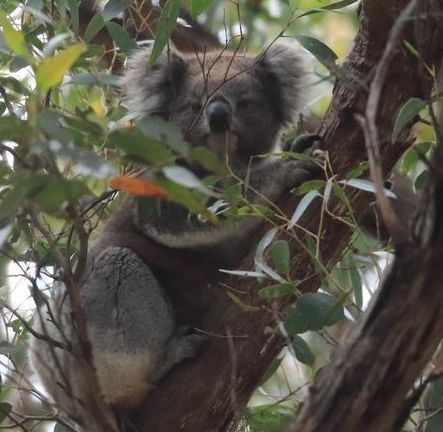

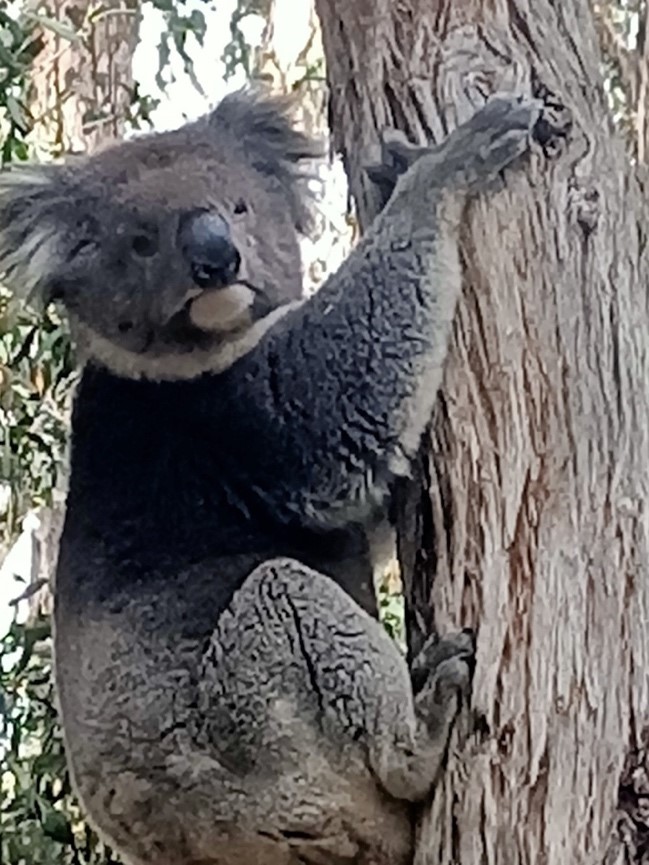
Image: courtesy of Rex
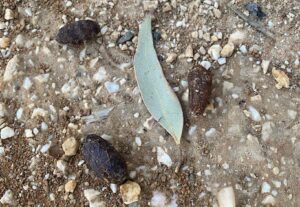
Total of FoCC Citizen Science Koala Count is now over 300.
- “Koala Counter” App
The CSIRO has developed a ‘Koala Counter’ App as part of the National Koala Monitoring Program (NKMP). Note: ‘Koala Counter’ is the most current CSIRO App – not to be confused with others of similar name.
The app is available at: https://apps.apple.com/au/app/nkmp-koalacounter/id6444713649
It has been designed to provide more information than just seeing a koala.
Part of its purpose is to find out where there are no koalas.
It asks users to describe quality of habitat and other info, using simple drop-down menus. It automatically records precise location co-ordinates. The information you provide is useful to CSIRO even when there are no koalas counted.
The App won’t be too difficult to use once the basics are mastered, and is available now, free through the App Store.
Some familiarity with it before ‘going out bush’ is recommended. It is quite straightforward to do a ‘single’ transect, and complete using the easy drop-down menus.
- Koala DNA project extended
Earlier this year the FoCC supported a Federation University Koala scat collection projection run by Siobhan Heenan.
Fresh Koala scat was collected locally for DNA analysis to help determine the genetic diversity of Western Victorian Koalas.
Some of the samples are now going to be included in DEECA’s Great Victorian Koala Survey, which is exciting.
DEECA is now working really hard to collect samples in the east over the Summer and into March next year. The opportunity exists to add samples from Western Victoria and Ballarat to the study.
Local student researcher Siobhan Heenan is once again looking for Koala scat. If you find a koala or scat contact Siobhan direct on 0437420865 or via foccinfo@gmail.com
How it is done youtube clip
The following is a link to a video of Kelly Smith who is coordinating the citizen scientists in the eastern regions of Victoria. She shows what koala scat looks like, the method of collecting and how to post them. This is for volunteers who might be keen on getting out there themselves!
https://www.youtube.com/watch?v=_FiG7y2caM4
- Natures Stewards courses for 2024
After two great Spring Nature Stewards programs in 2022 & 2023 the City of Ballarat are proud to announce that the first Autumn Nature Stewards program is open to registrations!
If you, friends, family or colleagues are interested in learning more about the natural environment in a fun, friendly and engaging way then Nature Stewards is for you:
Course info: https://vnpa.org.au/programs/nature-stewards-3/
Application page: https://vnpa.org.au/apply-for-nature-stewards/
Applications close Sun March 24th 2024 and spaces are limited This program is sponsored by the City of Ballarat and is an excellent program to learn more about the natural environment. Great for volunteers, friends’ groups and landholders.
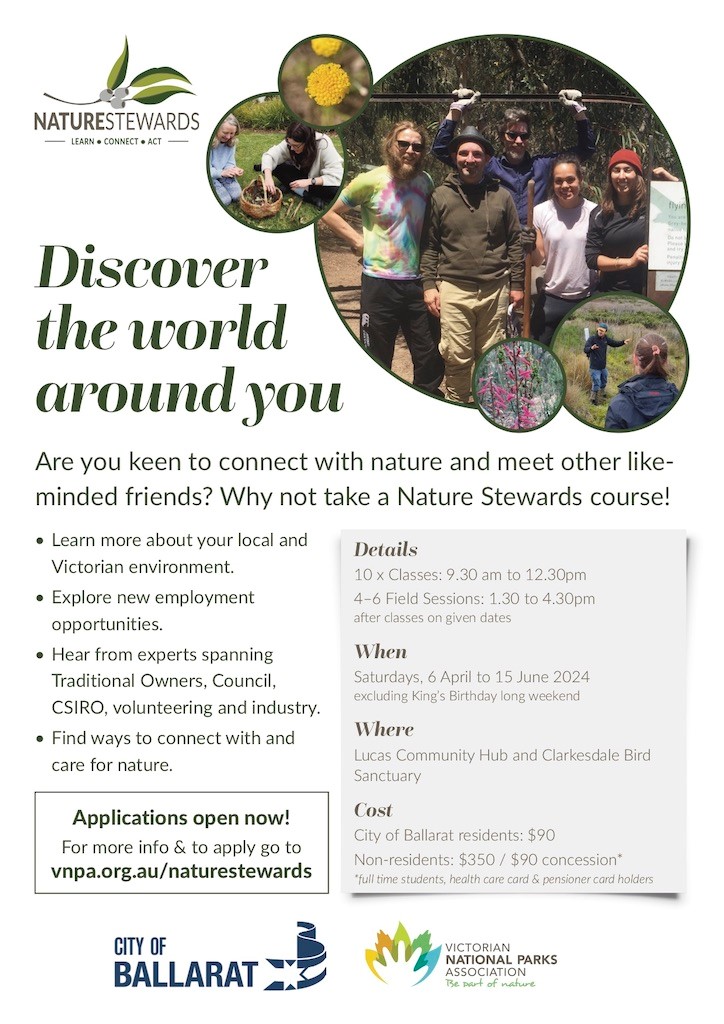
- Parks Victoria “Seeds of cooperation planted by Ballarat volunteers”
Parks Victoria published on November 22nd 2023 the following article on line:
“Seeds of cooperation planted by Ballarat volunteers”
The opening paragraph begins with: “From little things, big things grow.
That’s certainly the plan for a handful of volunteer groups in Ballarat who all play a vital part in caring for the local environment by taking care of native seeds at every step of their life cycle.
The extraordinary initiative begins and ends just south-east of the city in Woowookarung Regional Park, a 641-hectare bushland park that was created in 2016. Woowookarung means “place of plenty” and lies on the traditional lands of the Wadawurrung people.
The project is entirely led by volunteers, with multiple groups working independently yet collaboratively to collect, cultivate, and plant locally indigenous plants. Their goal is to restore Woowookarung to its natural state, creating habitat that can support Koalas and Powerful Owls.”
The full article can be read at: https://www.parks.vic.gov.au/news/2023/11/22/00/25/seeds-of-cooperation-planted-by-ballarat-volunteers
- FoCC tree planting map
The map below shows the locations of the FoCC tree planting areas. A total of 3700 trees have been planted with a success rate of 75% or more depending on the year.

- Yarrowee River explanation
The Yarrowee river was the subject of an excellent article from Federation University in “The Conversation” recently.
The article focussed on the shifted location of the Yarrowee river in central Ballarat as a result of gold mining.
- FoCC Membership for 2024 is now due.
Membership of the FoCC helps the FoCC in its advocacy, education and activities in support of the corridor. All 2023 FoCC members will receive am email notification that membership for 2024 is now due. Membership runs from 1st January to 31st December each year, Membership fee is $20 per year. Children of members are free.
To renew your membership: You can pay for membership via Trybooking at: https://www.trybooking.com/CFLFU
Cost is $20.50 via Trybooking. You can also make a donation of any size via this process.
Bank transfer to details: Bendigo Bank Buninyong BSB 633000 Account No 184147098
Note: Please add your name to the bank transfer and email foccinfo@gmail.com your name and the date of the transaction. If your postal address has changed, please let us know.
Payment to the Treasurer at a FoCC meeting or Cheques should be made out to “FoCC Incorporated” and addressed to: FoCC Treasurer, PO Box 83, Mt Clear Vic, 3350.
New Members
New members are most welcome: Applications after July are credited to the next year. Membership forms are available online or email foccinfo@gmail.com
- Bunny Trail Loop map
The Bunny trail loop map and guide was published for the opening of the Bunny Trail last month. The Bunny Trail Loop Map PDF can be accessed at: https://www.focc.asn.au/wp-content/uploads/2023/10/BunnyTrail-Trifold.pdf
- Rubbish dumpers, thieves and vandals
The FoCC encourages Park friends to report track vandals, rubbish dumpers, wood thieves and other suspicious activity to Parks Victoria on 13 1963 or email: woowookarung@parks.vic.gov.au
In emergency situations please call 000. If an offender is spotted, please note vehicle registration details as vehicle identification is most helpful, plus location and details.
- Useful information
- Parks Victoria Woowookarung email address: woowookarung@parks.vic.gov.au
- City of Ballarat wildlife information:
https://www.ballarat.vic.gov.au/me/pets-and-animals/wildlife
- DEECA wildlife issues reporting information
Report wildlife crime to Crime Stoppers Victoria on 1800 333 000.
Report any wildlife at immediate risk of deliberate harm or neglect to 136 186. Other matters relating to wildlife and wildlife management should use the 136 186 too.
The Help for Injured Wildlife tool will help you locate and contact the closest relevant wildlife carers and rescue and rehabilitation organisations to help the injured wildlife.
The main point is for any matters related to wildlife crime, call Crime Stoppers.
- FoCC Facebook and web
The FoCC has well over 1100 friends following us on Facebook and growing. Welcome to all new friends. Feel free to pass on to other friends and press the like button.
Rob is overseeing the webpage. webmaster@focc.asn.au
